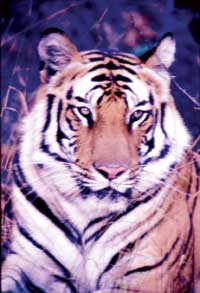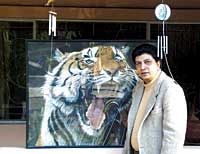 In Kathmandu's urban jungle, Nanda SJB Rana is restless again. But for a man who spends six to seven months a year tracking tigers and studying them at close range, this is understandable. Its been over two months that 46-year-old Nepal-born wildlife enthusiast and tiger expert has been in Kathmandu and he longs to return to the jungles of Bandhavgarh National Park in Madhya Pradesh, India.
In Kathmandu's urban jungle, Nanda SJB Rana is restless again. But for a man who spends six to seven months a year tracking tigers and studying them at close range, this is understandable. Its been over two months that 46-year-old Nepal-born wildlife enthusiast and tiger expert has been in Kathmandu and he longs to return to the jungles of Bandhavgarh National Park in Madhya Pradesh, India. "I go crazy if I stay in the city for more than a month," says the cat's best friend. But this is not a new-found adrenaline high for Rana. He has more or less grown up in the jungles.Till ten years ago, Nanda was an enthusiastic hunter until he admits he got his first chance to shoot a tiger. "I looked at his eyes and just couldn't do it. He was too beautiful to be killed for sport," Nanda told us. Today, he shoots them with a different weapon, a zoom lens. Rana's room is littered with thousands of tiger slides. We asked him for a sample of his work. He points to the heap on the floor: "Take any. They're all tigers."
 Nanda has been running the Bandhavgar Jungle Camp, the first privately operated jungle safari in India. Nanda still hunts whenever he gets the chance, but it is more usually a wild boar and other game that he needs to cull. "It's not that hunting is totally harmful. In Africa they have game reserves where enthusiasts can pay and hunt and this earns revenue that supports the local economy and conservation. But it has to be controlled," he adds.
Nanda has been running the Bandhavgar Jungle Camp, the first privately operated jungle safari in India. Nanda still hunts whenever he gets the chance, but it is more usually a wild boar and other game that he needs to cull. "It's not that hunting is totally harmful. In Africa they have game reserves where enthusiasts can pay and hunt and this earns revenue that supports the local economy and conservation. But it has to be controlled," he adds. Conservation however is not a responsibility Nanda has taken lightly. His passion for wildlife and especially tigers has been noticed by groups like National Geographic Society which hired him for a special on the big cats, The Eye of the Tiger. Nanda has recently finished with another film on tigers, The Tiger's Tale, which follows three generations of tigers over a course of three and half years.
After schooling in Kathmandu and Simla, Nanda spend much of his younger days canvassing for his father, Bharat Shamsher, in elections of a bygone era. Later he went to India and raced motorcycles, raised partridges, and hunted. The jungle is also where he met his wife, Latika, who is a PhD on tiger ecology. Nanda is planning to settle down in Nepal, and work in conservation here. And a lot of his focus is on education. He says, "We are saving these cats for our children, and they need to know why it is important."


